#movie franchise: somehow implies in any way shape or form that after the movie ends the characters all disperse into separate lives
Text
okay this is very far from the real point but is the jurassic world dominion trailer telling me that ellie sattler and alan grant are no longer together? they broke up? they’re no longer close and in each other’s lives? son of a fucking bitch
#laughs awkwardly#how dare you. do you understand how rare it is for me to root for a het couple??? how DARE you !!!!!!#there is already another couple that have the whole 'girl tells the guy to come back to main storyline' in the same trailer!!!#(not to mention in the previous movie. WITH THE SAME COUPLE)#it literally doesn't make any storytelling sense for ellie and alan not to still be together/married as a contrast to the main ship???#movie franchise: somehow implies in any way shape or form that after the movie ends the characters all disperse into separate lives#me who is very normal about found families: this is bullshit. 0/10 story i hate it. no i'm not tearing up look away#EDIT: listen i know ellie and alan are fine as a friend dynamic that's not what i'm pressed about. it's the 'catching up' in the trailer#EDIT: that implies they haven't met in a while that gets to me. like why can't they still be hanging out?? i don't have abandonment issues !#EDIT: but also in the og movie i genuinely appreciated that they felt like solid friends/partners first and couple second#EDIT: like they were just comfortable with each other without constantly talking about their relationship. and the trope where#EDIT: the guy starts out hating kids but then grows close to them is executed without any kind of romantic pressure from ellie#EDIT: or any insinuation that ellie and alan now plan to get married or have kids. it's just a subplot that alan has. the kids are just kids#EDIT: without being some kind of metaphor about men angsting about commitment or whatever. it was good dammit!! they were good!!!#EDIT 2: 'so what is the real point' all this nonsense about being 'out of control' 'subordinate to nature' is completely nonsensical#EDIT 2: the ISSUE is the ecological destruction that will be caused by multiple invasive species and the ripple effects across ecosystems#EDIT 2: [IF in fact the species invade successfully. which i understand for the sake of the movie yes of course they do]#EDIT 2: [but also like megafauna died out for a reason. being large takes too much energy to maintain so evolution downsized]#EDIT 2: [sorry this isn't important]#EDIT 2: NOT whether humans are still 'at the top of the food chain' cause bitch we never were. walk out into nature right now#EDIT 2: there already are many predators that can unalive humans anytime. to pose this as a dinosaurs vs. humans battle is just#EDIT 2: hilariously not understanding how the actual world and nature as it exists works. humans do not control nature that is the point?#EDIT 2: whatever. yeah i'll probably still watch the movie. i was gay for ellie sattler years ago and i will be again
1 note
·
View note
Text
A meta and analysis on Hurricane Touchdown
Hurricane Touchdown sure is one of the Digimon entries that’s really difficult to describe. Often said to be “confusing” and “like an acid trip” (for pretty good reason, honestly), it somehow also manages to have a lot of hold in public memory, partially due to being one of the three movies that got widespread international distribution via Digimon: The Movie. Moreover, its relevance has started to re-emerge thanks to Kizuna, the director of which has stated Hurricane Touchdown to be his favorite movie (multiple times). Rather recently, there was even an editorial written by a journalist who had been covering Kizuna, professing that he had watched Hurricane Touchdown as a kid and hated it, only to rewatch it as an adult and appreciate it much better.
With all that, plus the fact that the movie recently got a new translation, it’s probably a good time to go back over the movie and analyze it! Despite what popular sentiment may have you believe, the plot of the movie isn’t that fundamentally incomprehensible, just buried under some rather unusual production and execution decisions. But there’s a lot to be said about the themes and story of the movie, so let’s dig in!
(All screenshots and quotations from the movie are based off the Hudie translation.)
Hurricane Touchdown in meta franchise terms
The full title of the movie isn’t technically Hurricane Touchdown by itself, but rather “Digimon Hurricane Touchdown!!/Transcendent Evolution!! The Golden Digimentals”. (The Japanese fanbase tends to shorten it to “Digimon Hurricane”, or, for even more shortening, “dejihari”.) The double-titling there is because of how it was originally screened; it was the 02 “summer movie”, screening in July (between the airings of 02 episodes 14 and 15). Functionally, the franchise has thereafter treated it like a single movie, but at the time, the fact it was technically “two” movies gave it the longest running time of any Digimon theatrical movie, clocking in at a little over an hour. (The tri. movies are officially considered OVAs and not theatrical movies due to their limited-screening nature, so as of this writing Kizuna, at 95 minutes, is the only theatrical movie to break this record.)
The movie itself has a pretty fascinating development history – for one, Akiyama Ryou was originally planned to be the starring character instead of Wallace. It’s also the first Digimon movie to be in “questionable canonicity” territory – this is very normal for Toei tie-in movies, since development for these kinds of movies usually starts at the same time or even before the TV series itself, making it hard to reconcile canon, but unusual at the time for Adventure, which had both its first and second movies be plot-relevant to Adventure and 02 respectively. It is generally understood that the movie takes place in “summer” – possibly between episodes 14 and 15, at the same position it screened in real-life – but, interestingly, the Western and Japanese fanbases’ opinions on why it’s questionably canon tend to differ: in the West it’s usually based on the appearance of Tailmon and Patamon’s higher-level evolutionary forms (which shouldn’t be possible as per 02 episode 27), but in the Japanese fanbase it’s based on Wallace’s existence posing a timeline contradiction (according to Adventure episode 45, there shouldn’t be any Chosen Children before 1995, but the movie states that Wallace had been one before then). Add to that The Door to Summer, which seemingly contradicts the ending of the movie (in which Wallace and Gumimon find what’s implied to be Chocomon’s egg, whereas The Door to Summer has the line “Chocomon isn’t here anymore”), and everything is just a tangled mess.
Despite that, it’s pretty remarkable how lasting the movie has been in public memory. Even with all of the factors working against it – the fact it’s often accused of being confusing (or, by many a Japanese kid, boring and slow) or an acid trip – Wallace is a very popular character, more so than you’d expect for a “guest” character in a one-off movie, especially one so controversial. 02 fans often even consider him an honorary seventh member of the 02 group. His article on the Pixiv dictionary wiki is pretty surprisingly thorough, at that. Questionable canonicity aside, the fact The Door to Summer even exists is pretty significant – how many one-off questionably canon movies have you seen getting an actual sequel?
As an aside, Hurricane Touchdown has a bit of an interesting relationship with Ojamajo Doremi, which is in some sense classic Digimon’s sister series (it aired at around the same time as Adventure through Frontier, and was also headed by their producer, Seki Hiromi). Wallace was voiced by Miyahara Nami, a voice actress who grew up in an international school in Austria and thus speaks fluent German and English, thus often putting her in roles that require speaking one of those. (If you listen to Wallace’s Japanese speech through the movie, it has a very heavy accent, which is deliberately affected on Miyahara’s part.) A year later, Miyahara would be cast as major character Momoko in Motto! Ojamajo Doremi, and The Door to Summer would prominently feature Nat-chan, a girl voiced by Shishido Rumi, who voiced Ojamajo’s Onpu (who is generally agreed to be Doremi’s most popular character, and Shishido’s most famous role). Coincidence? Opportunistic casting? Who knows.
The movie itself
But that’s enough beating around the bush. Let’s get to the movie itself!

I’m not going to dwell on this too much because I’m going to be going more in detail about it below, but our story starts off in Wallace’s hometown of Summer Memory, a fictional rural village in Colorado, in 1995. (As mentioned earlier, this is a bit of a timeline contradiction; Adventure episode 45 establishes that “the one who wishes for stability” and the Agents didn’t get the idea of human Chosen Children until 1995, whereas the events of Hurricane Touchdown imply he’d been one before then.) Chocomon suddenly vanishes, and a gust of wind is left behind, implying that he must have been kidnapped. It’s not exactly said by what he was taken by (Digimon: The Movie ties it into Our War Game! by having both be traced to a “virus”, but no mention of such is made in the original Japanese version).
The mystery of what it is that took Chocomon away is never fully elaborated in the course of the movie, but as it goes on, it becomes increasingly apparent that it doesn’t actually matter. Why? Well, stay tuned.
So, timeskip to 2002!

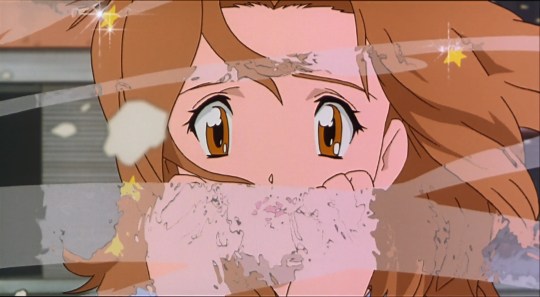

As Takeru and Hikari are visiting Mimi in New York, Hikari, who is known to have a bit of an empathic connection to Digimon, senses that there’s a “crying Digimon” (this will be important later), and Mimi suddenly vanishes – as do the other Chosen Children.
I think part of the reason this movie is often pinned as feeling like an acid trip is that the demeanor and attitude the 02 kids express in this movie feels a little too laid-back for the very urgent situation of their seniors having suddenly up and vanished (which is also not helped by the movie’s overall soundtrack being a lot more laid-back than the events on screen should suggest). This is especially odd because it’s absolutely not like the kids aren’t worried about their seniors at all! Rather to the contrary; “getting Taichi and the others back” is the major motive driving the whole group for the rest of it, and it’s constantly brought up as their goal in dialogue, shaping their actions throughout the rest of the movie. The execution of the dialogue and the overall direction create a bit of a tonal mismatch, but on its face, the actual storytelling checks.
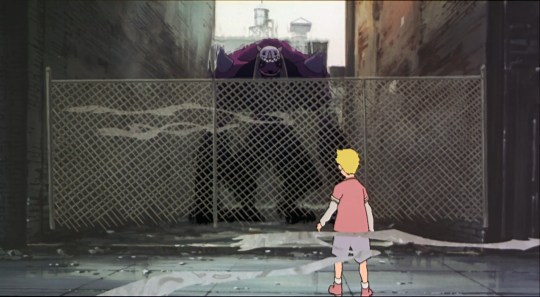
Shortly after, Chocomon – now evolved and corrupted into something – appears, and Wallace and Gumimon confront him.
The fact that Wallace refers to his partners by their Baby-level names (Chocomon and Gumimon) even after they’ve clearly evolved brings up a lot of interesting implications. One is that, not having been privy to any great adventure in the Digital World before, Wallace doesn’t have a lot of awareness of names changing after evolution the same way his Japanese peers do. But another important thing that comes out here is that, through the course of this movie, Wallace primarily sees his partners the same way he did as a young child. A lot of this movie’s story centers around Wallace’s difficulty in moving on from the past and accepting that things aren’t the same way that they are anymore – and so, just like how he has a hard time swallowing that the circumstances have changed, he has difficulty seeing his own partners as having changed, and calls them by the same names despite everything.
Takeru and Hikari catch on, and Hikari’s psychic sense catches on that something’s happened to her brother, too.
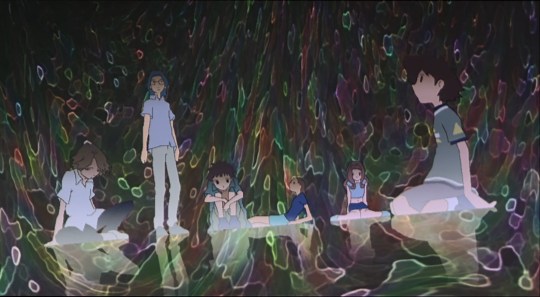
Oh, and incidentally, said seniors aren’t in a pleasant place to be in at all.
The fact that the older kids are clearly Not Having a Good Time in the realm they’ve been kidnapped to – it’s depicted as cold, lonely, full of negative emotions, and eating away at their ability to even bodily function – is very heavily connected to what we later learn about what’s been going on with Chocomon through the last seven years. Moreover, the one truly coherent thing Taichi and Yamato can spit out at this stage is concern for their siblings – i.e., love. Keep that in mind for later!
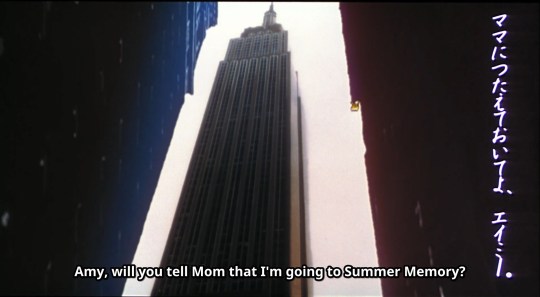
Wallace drops a line to his family (”Amy” presumably being his sister) saying that he’s going to head to Summer Memory, and skips town. Repeat: Summer Memory is in Colorado – he’s doing something as drastic as going out of state to follow Chocomon, which naturally does not amuse his mom very much (as we find out later in the movie). Patamon eavesdrops on the conversation and relays the information to Takeru and Hikari, who contact Daisuke in turn.
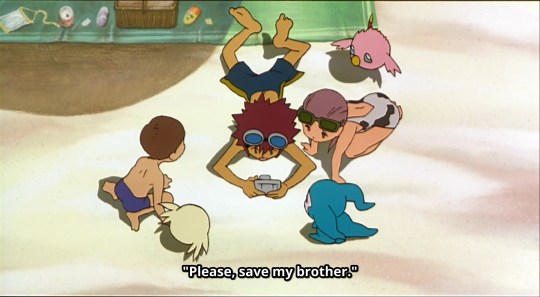



So the remaining three kids nyoom all the way to the US using frequent flyer miles (which makes you really wonder whose those are, or what on earth they told their parents to allow three elementary school kids go around unassisted in another country) to go save their seniors, which apparently doesn’t fund their trip all the way to Colorado, forcing them to hitchhike from New York.
(We also get a quick scene implying that Daisuke has better proficiency in English than Iori and Miyako, as he translates some of the statements for the guy they take a ride from. This is pretty surprising, given that Daisuke hasn’t really been portrayed as particularly book smart…but then again, language skills sometimes just happen to come naturally to some people regardless of skill in books, and hey, it might just come in useful for his future ramen chef career in New York…)
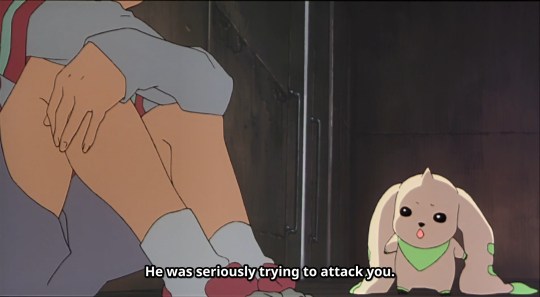
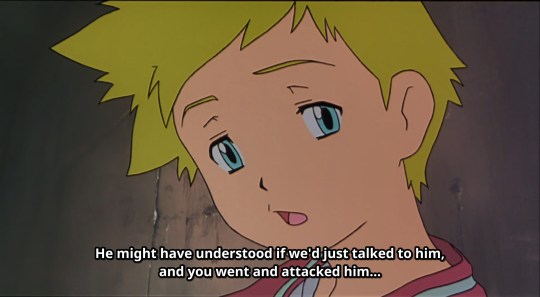
We get our first major scene of dialogue between Gumimon and Wallace, and we learn quite a bit about their characters in the process. Gumimon has a similar laid-back attitude to the more prominent Terriermon in Tamers, but beyond that (and a shared voice actress), it’s important to note that they have very different personalities otherwise. In this scene, Wallace and Gumimon get in an argument over how to handle Chocomon, with Wallace insisting that they shouldn’t have attacked him and that they should have just “talked” about it – even though, as Gumimon correctly points out, he was pretty obviously trying to physically attack Wallace.
In fact, at this part of the story, Wallace is being extremely irrational and in denial. You don’t even have to watch the rest of the movie to see that Gumimon’s very practical stance on the matter is reasonable – Chocomon was very much trying to attack Wallace, and getting caught in the fight was pretty much all he could do for Wallace’s safety. But Wallace, still stuck in the past, can’t accept that at this point in the movie, and, honestly, is being a bit of a brat about it too – he’s engaging in progressively more self-destructive behavior over the course of the movie (ditching his family to set off by himself in order to hitchhike to Colorado, for one). We later find out that Wallace is specifically obsessed with going back to the flower field where he lost Chocomon, having independently come up with the idea that this would somehow let everything go back to what it was before – even though there was really no sign this would actually fix anything.
The Adventure universe generally runs on a concept that a Digimon partner is representative of part of the self, and so, tying that into Wallace and his two partners, it can be taken that Gumimon and Chocomon reflect the duality of Wallace as a character – Chocomon representing his desire to latch onto the past and hope that everything can be the same that it was before, and Gumimon as Wallace’s sense of reason, advising him about the reality of the situation and how to practically get through it (and, thus, to move on). In fact, Gumimon is the one constantly advising him about said self-destructive behavior (reminding him that his mom is probably worried about him, but also berating him for just ditching the train as a result instead of thinking about how that’d leave them without reliable transportation for the rest of it).

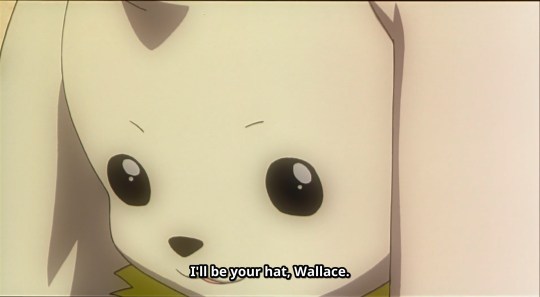
The symbolism is driven in even further when the only thing Gumimon has to say, in response to Wallace clinging further onto the idea that going to the flower field will fix things…is a cryptic statement that Chocomon didn’t like the heat, then suddenly offering to be a hat to provide Wallace shade. Because right now, Wallace and Chocomon are the same: clinging hopelessly to shards of the past.
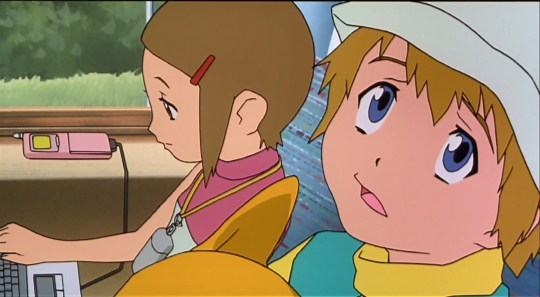
The other 02 kids make their way to meet up in Colorado, but run into some snags when Daisuke, Miyako, and Iori end up missing the exit to Denver (Takeru is not amused), and Hikari and Takeru’s train ends up stranded thanks to Chocomon’s interference…
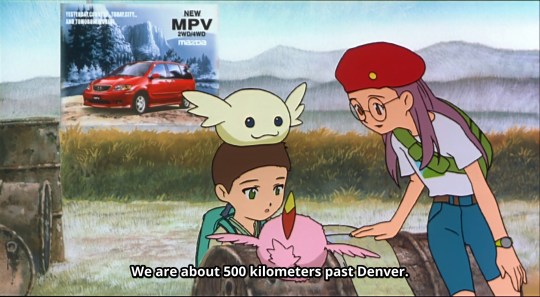
…and, making things worse, Daisuke, Miyako, and Iori try to take a plane back to Denver, only to overshoot it again. (Sorry, Taichi…your juniors are idiots.)
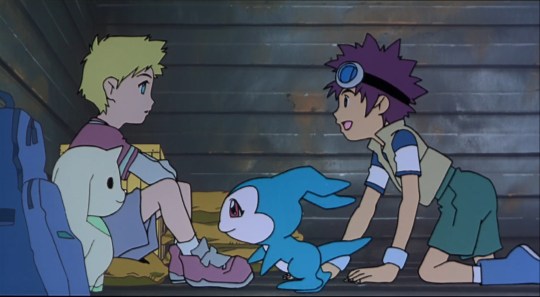
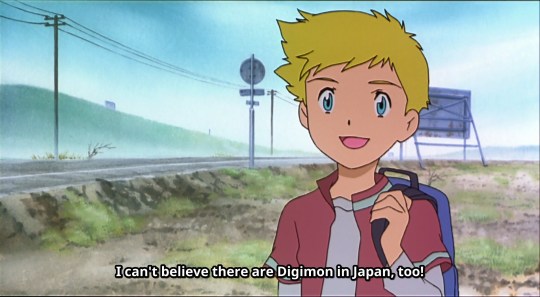

Fortunately, they get lucky by running into the very same boy they’re indirectly looking for on their way to hitchhiking. We learn that Wallace has never had exposure to other Chosen Children before to the extent of knowing there were any Digimon in Japan, nor has he ever been to the Digital World, so for all intents and purposes, his experiences with Chocomon and Gumimon are all he knows (i.e. he has no awareness of large-scale Digital World affairs). He also apparently speaks Japanese, which is convenient for this movie so that they don’t have to have a language barrier, but, amusingly, Wallace claims that it’s because he “had a Japanese girlfriend once”. (Gumimon, who is much more reliable of a source, says that he’d apparently put an honest effort into studying, so an interpretation that Wallace really likes anime or something is not out of the question.)
It’s also interesting to see how the others react to him, especially considering that it’s becoming increasingly apparent that he’s involved with the disappearance of their seniors. Miyako is as openly friendly as she generally always is, Iori presses him very calmly about questions relevant to the disappearances and Chocomon without even batting an eyelid (future lawyer in training here), and Daisuke is suspicious from the get-go…which is exacerbated when Wallace starts flirting with Miyako. The running gag of Daisuke getting angry about Wallace flirting with Miyako has a lot to unpack here – the most obvious standby is the shipping interpretation (or, at least, that Daisuke may be as protective of Miyako as he is Hikari), but there are other points to observe as well. Firstly, Daisuke is a rather abruptly straightforward and overly honest person, and it makes sense that he’d play badly with people who seem dishonest – after all, his suspicions of Wallace started even before he started flirting, and he also shows similar hostility around Takeru (also not a very straightforward person) when he suspects he’s being made fun of. But also, the Pixiv dictionary entry takes the interpretation that Wallace’s personality had gotten a bit “warped” by his experiences – or, in other words, he’d developed this penchant for acting like a flirt, wandering off on his own, and altogether being incredibly wishy-washy because of the trauma of losing Chocomon and his inability to get over it.


And as much as Daisuke’s being a prick about it (to the point that mocking Wallace for it gets him left there stranded with him), he’s absolutely right about the contradiction Wallace’s posing – he’s acting all high and mighty about trying to become an “adult” (meaning that going off on his own and flirting with girls presumably are part of his perception of what Mature Guys do), yet he’s being a total mama’s boy by constantly dropping everything to call her repeatedly through his trip. (It’s even worse than the subs here suggest; he calls her “mama”, the kind of super-affectionate language used by Mimi and Ken.) As Gumimon says, Wallace thinks he’s actually right, but he doesn’t actually have it together at all.
Another interesting thing to note here is that at this point of the movie, Wallace calls Daisuke “Daisuke-kun” (with honorific attached, slight distance). Remember this for later.
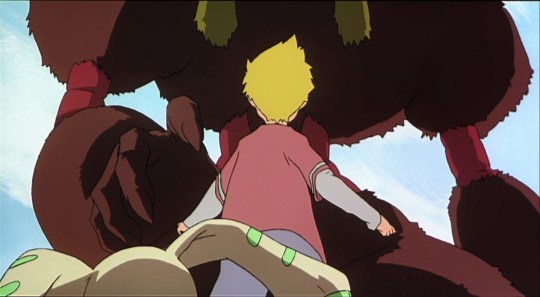

Chocomon appears to confront them again, but he seems to not properly recognize Wallace – because, as we later find out, he doesn’t see the current Wallace as “Wallace”, and will accept nothing less than a younger Wallace from exactly the way he was when they were separated. (It is later stated in the movie that this is why he kidnapped the seniors and turned them younger; since he can’t recognize “Wallace” the way he is now, he’s taking anyone he can find with a Digivice and de-aging them in the hopes that he’ll find “Wallace” among them.) Gumimon recognizes that Chocomon is beyond recognition, and tells Wallace to not see him as Chocomon, but Wallace refuses to accept this and continues to intervene in the fight, telling Chocomon that they’ll meet again in the flower field. Again, Wallace’s mentality isn’t that different from Chocomon’s at this point – he may not be delusional to the point he wants to literally turn back time, but he still thinks that reproducing the conditions of seven years prior will fix everything and make it all better again.
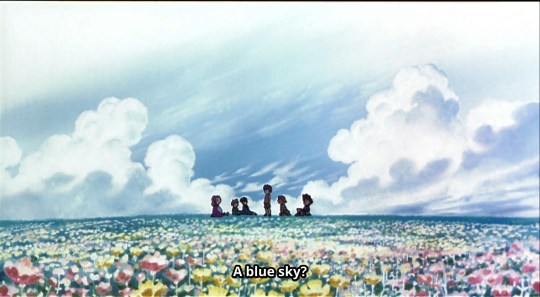
During this whole time, the older(?) kids are getting progressively younger, and it’s turning out to impact not only their physical bodies but also their mentalities. At this point, they’re starting to lose awareness of what’s happening to them, as they become more and more connected to Chocomon’s emotions.
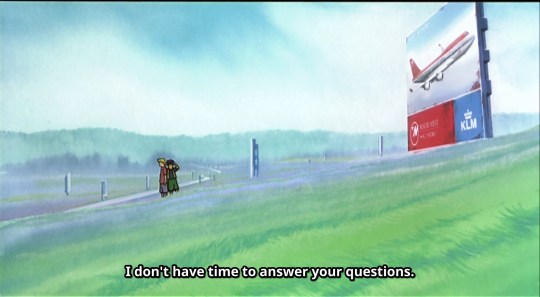
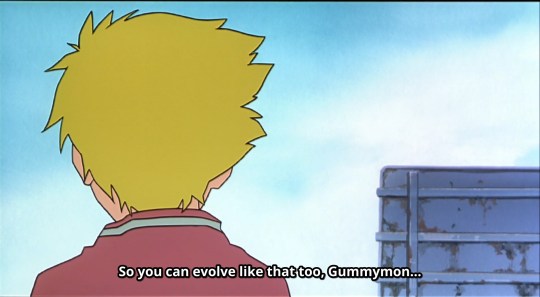
Daisuke is smart enough to catch on that Wallace definitely knows what’s going on, and starts to interrogate him. Recall that Daisuke is completely within his rights to do so at this point – Wallace is not only acting incredibly shady, he’s also being dismissive and refusing to give Daisuke any concrete answers about something that most certainly involves him at this point. As the 02 kids keep reiterating, their seniors have been kidnapped, and it’s pretty clear to anyone that Wallace knows something about this, but he continues to blow them off.
Wallace also doesn’t seem to be very happy about the fact Gumimon had evolved during the battle – remember, Wallace is very resistant to changes in his status quo, and especially when it involves Gumimon evolving in a similar way to Chocomon.
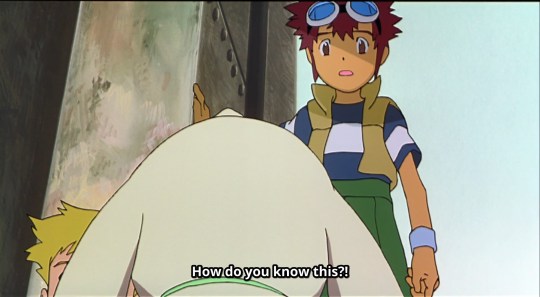
Daisuke continues to pry into what’s going on with Wallace and Chocomon, and Gumimon, who understands that there’s no use in denying that this is a problem, tries to be straightforward about it – but Wallace, still stubbornly refusing to open up about it, won’t even let Gumimon tell Daisuke about the truth.

Daisuke realizes that they’re not going to make any territory as it is, so he decides to have Lighdramon take them to Summer Memory for the time being, bonding a bit more with Wallace in the process.
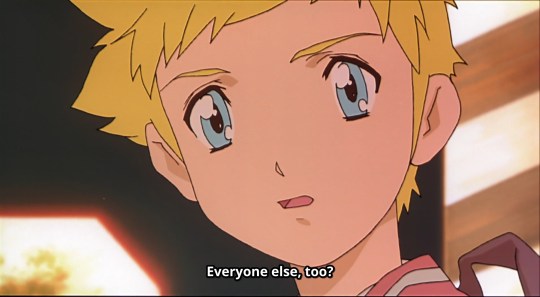
Once they reach Summer Memory, the kids learn about Takeru and Hikari getting stalled by Chocomon on the train, and the fact everyone else on it had disappeared – meaning that the responsibility that Wallace is carrying for not taking care of this problem begins to weigh further on him. Daisuke, Miyako, and Iori continue to interrogate him about what he knows.

But Wallace, still stubbornly, refuses to talk, and being in Summer Memory only drowns him in further memories of his past with Chocomon and Gumimon. We learn a bit more about Gumimon’s past, too – apparently, he was quite the crybaby…
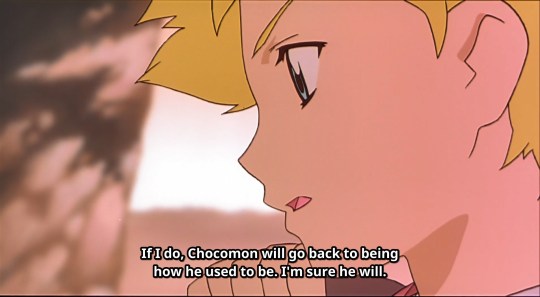
And when Gumimon finally begins to spill the details of what’s going on – that Chocomon wants to see the younger Wallace and is kidnapping kids with his Digivice and turning them younger as a result – Wallace still continues to double down on his denial. Notice his wording – his specific insistence that things will go back to “how they used to be,” because it’s not just about getting Chocomon back, but also a fixation on recreating that happy childhood he had with him.
(There’s also a bit of a cute moment around here where Daisuke asks Wallace if he needs to call his mom – after having teased him for being a mama’s boy earlier, Daisuke really is starting to care about his welfare. It’s also amusingly mentioned that Daisuke, Miyako, and Iori are broke out of money until they meet up with Takeru and Hikari again…)
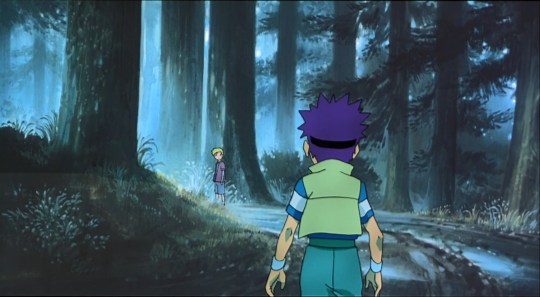
That night, Wallace tries to go off by himself to the flower field, not even bringing Gumimon with him – as he implies later, he doesn’t even want to get Gumimon involved with this because he was the closest to Chocomon – but Daisuke, having finally caught on to his suspicion that Chocomon is not only relevant to Wallace but also Wallace’s partner, confronts him about it. Wallace thus finally spills the details – that Gumimon and Chocomon were born from the same egg, that Wallace kept them from his mother and stuck with them during childhood, and that, seven years prior, Chocomon suddenly vanished while they were playing at the flower field.
Wallace: I’ve never been able to forget about Chocomon since then. Not even after moving to New York, not even once. We were such good friends…So why did Chocomon have to end up like that? Does he hate me for not being able to save him?
Daisuke: So the enemy we’re fighting is actually your Digimon? Your most important friend?!
Daisuke: Of course you’d never be okay with that…
Daisuke is in shock, even though he’d already started to suspect this.
I said, earlier, that Wallace is being extremely irrational and in denial. I did not say that his feelings aren’t valid. Wallace’s situation sucks, and Daisuke recognizes why this hurts for him so much, especially after putting himself in Wallace’s shoes (and in fact it’s even worse for Wallace; Daisuke’s only known V-mon for less than half a year, whereas Wallace is talking about his formative childhood friend).

Daisuke: I’d never be able to do it. If V-mon were to turn into something completely different…Even if he went on a horrible rampage…There’s no way I’d ever be able to bring V-mon down.
Wallace: Daisuke…
Daisuke: So then, what are we supposed to do?
Wallace: It’s not something you need to be crying over.
Daisuke: But…
This entire scene is an interesting one for many reasons, especially because of the position in which it aired – this was in the middle of the arc in 02 when everyone was getting their second Digimentals. Daisuke had, only a few episodes prior, expressed trepidation over “friendly fire” – fighting any friend who had become controlled by the Digimon Kaiser. This is consistent with that (and the 02 kids’ general bleeding hearts and difficulty with fighting friends), and it’s even worse – unlike before, when we were talking about evil mind control, Chocomon is pretty obviously a victim of his own madness. And although Wallace continues to insist that this isn’t Daisuke’s problem, Daisuke, for all he’s rough around the edges, is a genuinely kind person who thinks of others to the point he breaks down in genuine tears over the problem, and it’s consistent with not only his prior characterization of thinking about others’ feelings in 02 episode 8, but also how this eventually ties into his indignation over seeing others being hurt (episode 20) or their feelings being trampled on (episode 49).
Another interesting thing here is that at no point in the movie is “killing” ever brought up, but rather the word used is taosu, which literally means “defeat”. In 02 proper, its use is somewhat euphemistic – most famously, it was used in episode 44, when Miyako and Hawkmon have a crisis over killing LadyDevimon (so in short, there’s no illusions about the fact killing is in play here). But in this context, it’s not even really about killing. Wallace doesn’t even want to fight in the first place. The sheer action of physically beating up a beloved friend is painful, with killing as the ultimate unwanted outcome. Everything about this sucks. But Daisuke correctly points out that Taichi and the others’ welfare is on the line here, and everything feels like the wrong thing to do. “What are we supposed to do?”, indeed.
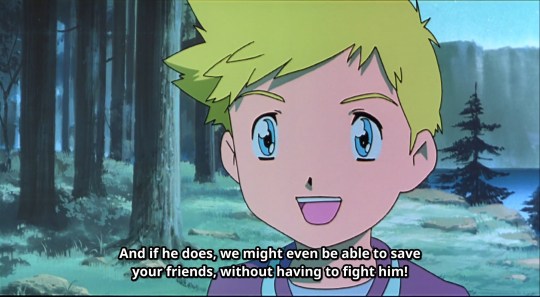
So that’s why Daisuke momentarily indulges in Wallace’s denial-induced pattern of thought, because it really does seem like the only out here. (Especially because, from Daisuke’s perspective, Wallace seems to understands this situation better than he does – even if he doesn’t actually.) If they go to the flower field, they won’t have to fight and everyone will be saved and it’ll be fine! Wallace is irrational and in denial, but you can’t blame him and Daisuke for really, really wanting to believe this.
And Daisuke drops this zinger of a line, too:
Daisuke: So don’t say you’re gonna go alone.
Daisuke’s characterization really is important here, because, again, this movie came out during the first arc of the series, before episode 21 and the second half that centered around Ichijouji Ken’s redemption. At this point in the series, Daisuke was still being extremely deferential to others, especially his seniors, in almost all cases, and although episode 8 was a momentary glimpse into the kind of resolve Daisuke could have when it involved something he really cared about, this movie is really the first major sneak peek into how supportive of a person Daisuke is going to develop into, especially when it comes to Ken.
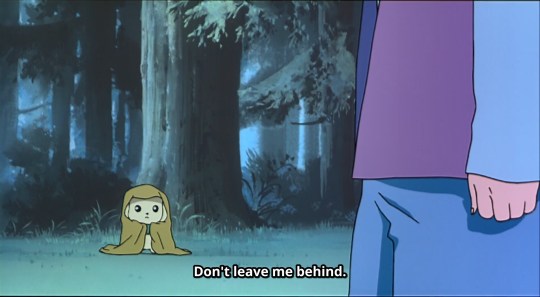
And Gumimon reaffirms that he’s going to stick by Wallace no matter what – filling the traditional role of a partner that Chocomon won’t anymore.
So they go to the flower field, and everything…fails spectacularly.
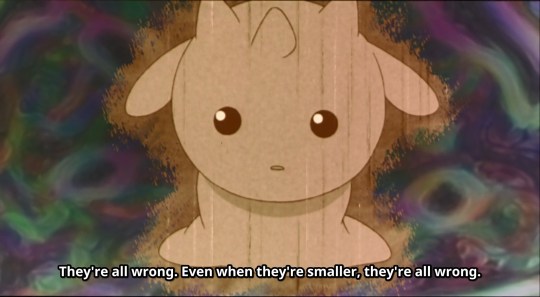
Well, before that, we get a glimpse of how the older kids are doing (they’re barely even conscious now), and we finally get to see Chocomon “in his element” and not as a rampaging monster. Things really, really aren’t going great for Chocomon either. He desperately and sadly jumps among the kids, trying to find Wallace among them, and what he really, really wants is just to be with his partner again. But they’re all “wrong”…
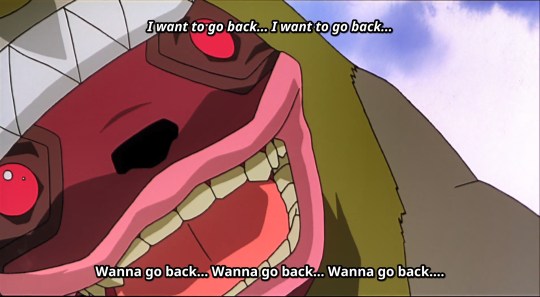
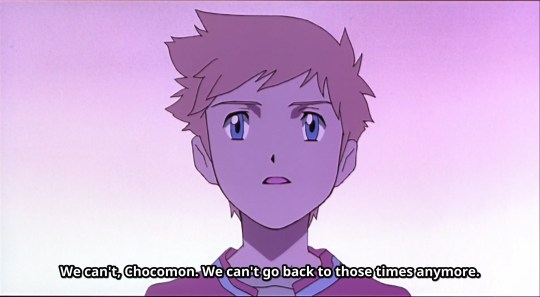

At first it seems like Wallace is making headway – for a second, Chocomon even recognizes him as Wallace! – but he continues to insist that he wants Wallace to come “with him”, to where it’s “cold and lonely and no one is there”. The way he starts chanting that he wants to go back is represented by the young Chocomon’s voice getting progressively lost in the monster’s voice, and Wallace, starting to grasp how futile Chocomon’s clinging to the past is, makes his first statement of the movie’s core theme: you can’t go back to the past, the only thing you can do is look forward and think about what you can do from there.
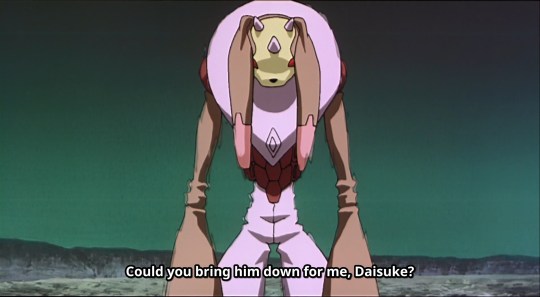

So after witnessing very clearly, in front of his eyes, how Chocomon is not going to listen to reason and will accept nothing less than something he can’t have, to the point of evolving and distorting everything around him, Wallace’s denial finally hits its limits, and he accepts that fighting him will be the only option out. (Again, note the use of “defeat” here – it’s not really about beelining straight to euthanizing him as much as Wallace has finally gotten over his refusal to fight Chocomon at all.) And considering that the situation is clearly rapidly escalating, and that Chocomon himself is clearly not in sound mind and having a terrible time himself, it doesn’t take much to see why the bleeding-heart Daisuke would also end up conceding so quickly. There’s a limit to how much you can hold out with pacifism when that just happened right in front of you!
(Also, Wallace no longer uses the honorific on Daisuke. Friendship level up!)
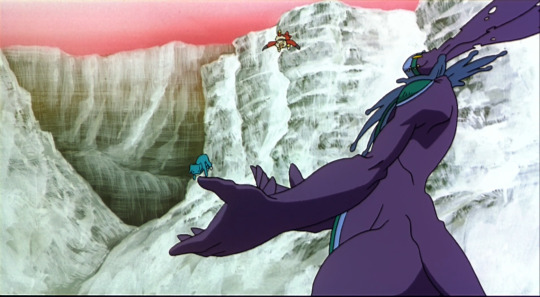
Chocomon evolves further and further, and his personality starts to actually take a turn for the cruel as he starts toying with the Digimon. In fact, it’s made pretty apparent that they’re no match for him from the get-go – he keeps toying with reality and forcing the Digimon back and forth between forms. He ends up “altering the world” into something reflective of his own heart, and it’s repeatedly pointed out that it’s “cold and lonely” – in short, Chocomon is subjecting the world to feel the same pain and loneliness that he felt, the pain that was enough to drive him mad.
And Wallace finally has this to say:
Wallace: Like Daisuke said, I’m a big baby. But you’re not Chocomon anymore. No, you’re the one who did this to Chocomon…Chocomon was all by himself and lonely, and in that loneliness, he tried so hard…But you took his heart and locked it away somewhere! I’m going to fight. If I defeat you…If that means I can free Chocomon from you…Then I want to fight, too! I need strength…
Firstly, Wallace acknowledges that he’s been a brat – that he’s been philandering around and acting spoiled and stringing everyone around (character development!!). And secondly, Wallace finally acknowledges the truth of Chocomon no longer being recognizable anymore. The ending quarter of this movie focuses heavily on the idea that Chocomon has now become so distorted that he can no longer even be considered the same thing anymore – it’s ambiguous as to whether that “you” that Wallace refers to having taken Chocomon away is actually a separate supernatural entity, or whether Chocomon was drowning in his own loneliness to the point those negative feelings became their own entity and consumed him.
In actuality, though – it doesn’t really matter! 02 as a series would also go on to blur the boundaries between external interference and internal forces – Ken having the Dark Seed as an influence but also being personally responsible for his own emotions driving him over the edge, and having to take responsibility regardless, and Oikawa technically being possessed by Vamdemon but still being goaded on by his own fixation with the past (in fact, notice how all three of these cases have to do with a fixation on things that can’t be brought back). Right now, the only thing that matters is that Chocomon is no longer recognizable, the thing in front of Wallace is no longer the same friend he knew, and even being able to bring back Chocomon’s sense of self is something Wallace wants.
(Daisuke also throws in a more charitable interpretation of Wallace’s actions even when he’s being hard on himself, pointing out that he can’t really be called a “baby” when he also did have genuine determination to come all the way there to find Chocomon despite his age.)

Hikari and Takeru arrive on the scene, and after Daisuke loses his marbles a bit over his happiness at seeing Hikari-chan there, Hikari points out the same thing: “You’re not the Digimon that was crying.”
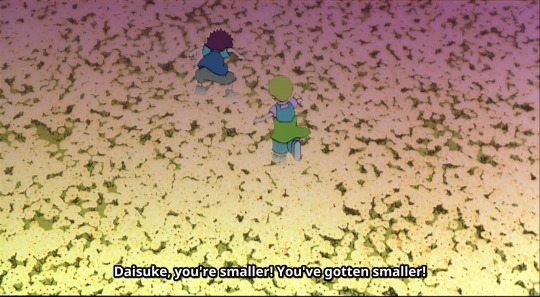
Chocomon starts turning the 02 kids younger too – and remember, it was established earlier that he was using the Digivice as a guide. That meant it made sense for him to target the older kids, since they had the same model of Digivice Wallace did. But Daisuke and the others have D-3s, and there’s no way to really mistake them for Wallace – so in other words, Chocomon has devolved to inflicting cruelty for no good reason, with the original motive having completely vanished.
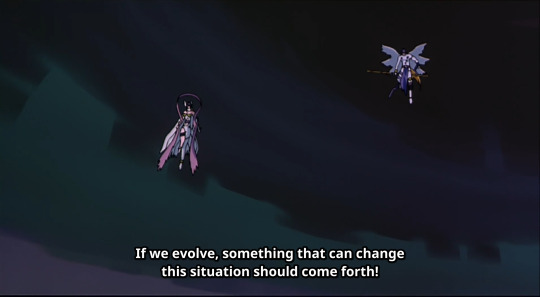
In increasing desperation, Angewomon and Angemon decide to evolve, and…look, I don’t have an explanation either, but I have to admit I’m somewhat amused by the fact that even they don’t really seem to have an explanation beyond “well, we’re desperate and hopefully it’ll do something!”
So they evolve, and Chocomon oneshots them. But that’s okay, because they released some golden Digimentals for Daisuke and Wallace to use! So V-mon and Gumimon get shiny new golden forms –


– and Chocomon pretty much oneshots them, too. More specifically, he eats them…and within his body, Magnamon and Gumimon’s consciousness gets eaten apart to the point they start forgetting their partners. Wow, this situation just got worse.
Yeah, so, despite the movie being named after the golden Digimentals, the actual point being here is that power means absolutely nothing in this situation. Remember, I pointed out that even from the beginning Chocomon was straight-out warping reality – they really didn’t have a chance.
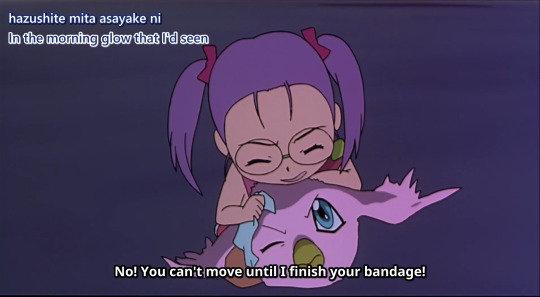

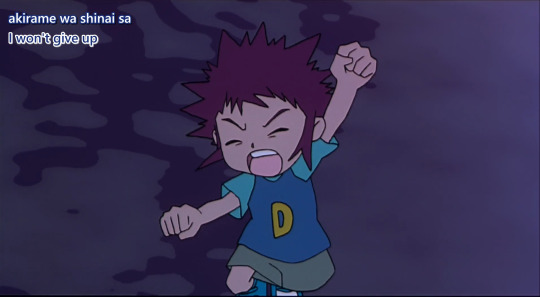
So basically, everything devolves into complete chaos. Everyone’s being turned into little kids, with the mentality to match. All the Digimon are being oneshotted and being tossed around like tissues. But the one constant through all of this is that the kids are constantly running after their partners.
Remember how, back when the older kids were first getting sucked into Chocomon’s world, the one thing that seemed to remain intact at first was “love”? That “love” is what reaches out to Magnamon and Gumimon inside Chocomon, and makes them remember their partners again.
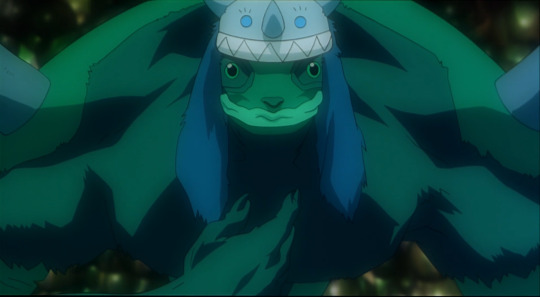
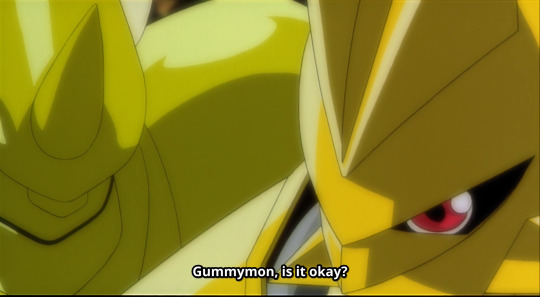
And, more importantly, that “love” is what awakens Chocomon – the real Chocomon – inside his consciousness, and he wordlessly makes a gesture begging Magnamon and Gumimon to kill him. And so they do – with understanding and consent from all three involved.

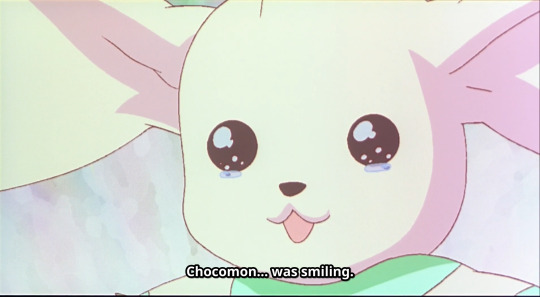

So in the end, the most extreme conclusion was reached. Chocomon died, at the hands of Daisuke and Wallace’s partners. But in that moment before he died, Chocomon’s pain was relieved, and he was himself again – Gumimon says that “Chocomon was smiling”, even in spite of his usual personality being that of a crybaby. They may have failed in their struggle to prevent the inevitable conclusion of having to kill Chocomon, but they did, to some degree, “save” him – so all of it did mean something in the end. And Daisuke promises that this still doesn’t mean the end of everything – they may have not been able to bring back Chocomon, and especially not in the exact way that would make things “the way they were before”, but the future is still there for him to return someday.

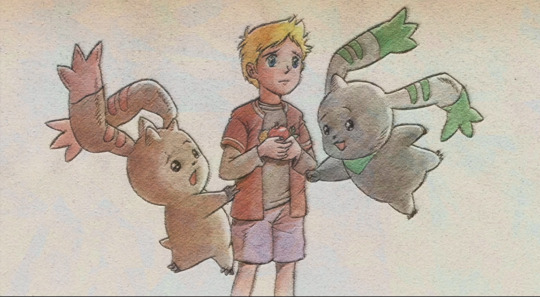
So, we clean up loose ends. Taichi and the others are returned safely, and in the end, Wallace decides to still be a vagrant for a bit longer – and to flirt with Hikari and Miyako a bit before he leaves. In the end, Wallace still has a long way to go if he wants to really grow as a person. But as Miyako points out, he’s gotten a bit bolder than he was before – and he’s greeted with an egg in the end, as if opening up new possibilities.
The Door to Summer contradicts the finding of this egg, or at least opens up the possibility that this wasn’t actually Chocomon’s, so it’s ambiguous as to whether the frame of Terriermon and Lopmon at the end of the credits is meant to be taken literally, or if it’s just symbolic. But even in the case of the latter, Chocomon is seen as Lopmon, a form he never got to have in Wallace’s childhood – so, in the end, it’s about different possibilities opening up in the future, rather than replicating that of the past.
All right, let’s recap this movie for those doing a tl;dr! Or, more specifically, let’s recap the events in chronological order:
Sometime before 1995, an egg emerges from Wallace’s mother’s computer, and hatches into twin Digimon, Chocomon and Gumimon.
In 1995, while playing in a flower field in Summer Memory with Wallace and Gumimon, Chocomon disappears for unknown reasons.
For the next seven years, Chocomon is trapped in delirium, full of loneliness and pain from being unable to see Wallace, and starts to become obsessed with the idea of reuniting with him, but, in his madness, accepts only a version of that reunion that involves him being the same young child he was when they parted, as if nothing had changed since.
Wallace, likewise, develops a fixation with getting Chocomon back so that things can be like “the way they were before”, even after moving to New York.
In 2002, Chocomon begins to kidnap kids with the same model of Digivice that Wallace has, and starts to forcibly turn them younger and send them into delirium like his own, hoping that this will bring the “Wallace” he wants back. Wallace starts to chase after him and decides that returning to the flower field in Summer Memory will allow him to communicate with Chocomon and make him go back to the way he was before.
Takeru and Hikari, hoping to find a lead on their seniors’ disappearance, drop a line to Daisuke, Miyako, and Iori, who head to the United States, also hoping to find a lead in Summer Memory. On the way, they run into Wallace, who is evasive about his connection to Chocomon and the kidnapping incidents.
At Summer Memory, Daisuke confronts Wallace and learns about his story, emphasizing deeply with the difficulty in killing an important friend, and agreeing that they should reach out to Chocomon at the flower field.
Chocomon continues to fall deeper into madness at the flower field, and Wallace and the others realize that they have no choice but to fight him. As Chocomon becomes so distorted he’s no longer recognizable, Wallace declares an intent to at least save his consciousness.
As the fight carries on, the kids are de-aged by Chocomon in his madness, and Magnamon (V-mon) and Gumimon are swallowed by Chocomon. However, the kids’ love for their partners awakens Chocomon’s consciousness again, and he asks Magnamon and Gumimon to end his pain.
With everything settled, Wallace and Gumimon are able to face forward into the future in the hopes of meeting Chocomon again and starting anew from scratch.
The Door to Summer
Actually, there’s not much to really be said about Hurricane Touchdown’s spiritual sequel The Door to Summer, except that it revisits similar territory to the movie, observing it more in Daisuke’s context than it does Wallace’s. (The story is very much more Daisuke’s than it is Wallace or Mimi’s.) The short synopsis is that Daisuke, having had a pretty bad time recently, finds himself in contact with a mysterious “winter” (in the middle of summer!) that seems to reflect his own heart…and a mysterious amnesiac girl whom Mimi names Onpu “Nat-chan”, who immediately latches onto Daisuke. In the end, “Nat-chan” turns out to be “a Digimon who’s taken in a lot of evil data,” who goes on a rampage and forces the others to fight and eventually kill her.
Although the reason for Nat-chan going on a rampage is more concrete than what was given in Hurricane Touchdown (it’s portrayed as “data chips” that seem like fireflies), The Door to Summer also makes it very clear that it wasn’t just supernatural influence, but also Nat-chan’s loneliness, desire for a human partner, and jealousy of Daisuke and V-mon’s relationship. Daisuke, while showing immense hesitation about fighting her when she had befriended them, still manages to “save” her in some way, to the point she actually verbally thanks him as she dies. And in the end, Daisuke and the others decide to take her egg and find a partner for her – even if she can’t be Daisuke’s partner like she wanted, she can still start anew with someone else.
Wallace in Kizuna
Warning: The rest of this post contains spoilers for Kizuna.
As said before, Hurricane Touchdown has been said to be the favorite Digimon movie of the director of Kizuna – and certainly, while Kizuna references all four Adventure-series theatrical movies, Hurricane Touchdown’s references are the least subtle, with the plot point of de-aging kids lifted directly from it. (Except, in this case, it’s in the context of trapping oneself in blissful memories rather than being portrayed as the upfront listless torture it is in Hurricane Touchdown.) Moreover, the theme of warning against being fixated on the past is just as present in Kizuna as it was in Hurricane Touchdown, especially when Kizuna’s main antagonist (Menoa) also falls victim to something that’s part supernatural influence and part getting swallowed by her own negative feelings…so it’s only fitting that Wallace himself makes a cameo in the movie. Two cameos, in fact.


The fact that Wallace is established as canonically existing within the Adventure main timeline has thrown a lot of people for a loop, especially since recent franchise events have made it questionable as to how it’s possible for canon to even make sense anymore because consistency has just gone out the window, but the Pixiv dictionary’s chosen rationalization for this is that, at the very least, “(some version of) Wallace exists in the timeline of the main story”. I’m inclined to agree with this evaluation; the fact that people around the globe can agree that the movie is questionably canonical but can’t even agree on how, and the fact that certain franchise entries considered canon (Tag Tamers) have their own contradictions, plus the fact that it’s not like Hurricane Touchdown takes a complete knife to timeline and lore common sense and more that it has some contradictory minutiae that are really easy to sidestep, it’s not actually that hard to say that some timeline of events that reasonably resembled Hurricane Touchdown (with maybe only some minor timeline or evolution differences) happened during the summer of 2002, and thus that Wallace exists.
Assuming that the story of our canonical Wallace is mostly the same or similar to that of the story presented in Hurricane Touchdown, Kizuna provides us with quite a bit of interesting information. We’re treated to two shots relevant to him: one in the form of his name at the top of Koushirou’s list of kidnapping victims, and one where he appears in person at the very end. It’s hard to miss him; he’s wearing similar colors to the clothes he wore in Hurricane Touchdown so you can identify him even at a distance, and he’s also the only loser around here with two partners. That’s right, two! Two!! Chocomon is back – and as Lopmon, exactly like the end credits card of Hurricane Touchdown depicted him!
So it looks like that, one way or another (after Hurricane Touchdown, after The Door to Summer, whatever, make up your own story), Wallace did manage to reunite with Chocomon and start a new life with him. It looks like not all of his habits have died – he’s depicted in a place with palm trees, meaning he’s definitely not in New York or Colorado, so either he’s moved again, is still maintaining the vagrant lifestyle, or just happens to be on vacation.
The other interesting thing here is that Wallace is depicted as one of the Eosmon kidnapping victims. According to Menoa, kidnapping victims were ones who were entertaining thoughts of wanting to go back to the past and remain a child forever – something that should intuitively be against everything Wallace learned in Hurricane Touchdown. But it’s important to point out that Eosmon’s lure is depicted as working on a subconscious level – certainly, if the kidnapping victims in Kizuna were to be outright asked if they wanted to be kidnapped and de-aged and trapped in their childhoods forever, most of them would probably say “no!”, and Wallace is likely no exception! But even if he’s starting his life anew with Chocomon now, it’s not hard to believe that there would still be lingering subconscious regrets about everything he’d lost with Chocomon and the childhood they could never spend together, ones that Eosmon’s allure would end up connecting with, even if the events of Hurricane Touchdown had consciously taught him better. Alas, being a human is hard.
#digimon#digimon adventure 02#hurricane touchdown#shihameta#digimon adventure last evolution kizuna#kizuna spoilers
111 notes
·
View notes
Text
Endgame thoughts
My initial reaction was that it’s surprisingly really slow paced and has very few action scenes. I was going to say it was all ultimately worth it for the big climactic battle at the end. But then it really lost me on almost all the endings for our heroes.
Pretty much everything I dreaded came to pass. Tony had five years with his wife and kid, but he had to live those years in a super-depressed world where he felt like a failure, then when he had the chance to fix everything and settle down and finally enjoy life, they ripped it away from him. Also, kinda selfish of him to insist that they don’t erase the last five years on the off chance that it causes Tony to not get married and have a kid with Pepper. Like, fuck all the people who didn’t get dusted but died as a result of pilots and drivers and doctors suddenly disappearing or who became depressed and were driven to suicide and fuck Loki, Heimdall, Vision, Gamora, and half of Asgard I guess?
Similar to how they ended Tony’s story about PTSD, survivor’s guilt, and the overbearing burden of feeling like he has to be responsible for everything in the worst way possible, I feel like Steve’s ending was also antithetical to his entire arc. He spent the whole series trying to acclimate to life in the future and he was doing a pretty good job of it. He got caught up on tech, pop culture, and even found a new love, bland and underdeveloped as she was. Then he just goes back in time to live in the past? Also, the whole point of sending Steve back to return all the stones was to ensure the timeline didn’t get fucked and things would play out as they had originally, so Tony’s daughter wouldn’t be unborn. But then Steve goes and hooks up with Peggy, who got married to someone else in the original timeline. Also, no one noticed Captain America returning after being presumed dead in a time where memories of him and what he looked like would still be fresh? Also, also Peggy founded SHIELD. Did she have to hide Steve’s existence from everyone who knew him every day that she worked with them? Did Steve not warn her about HYDRA infiltrating her organization? What about in the future when those HYDRA agents were tricked into thinking Steve was one of them? Any consequences to that?
I think the biggest tragedy of Steve’s ending is that it could’ve been the most beautiful, perfect, satisfying, sentimental ending to another story. Like, if they’d done this at the end of Avengers 1, or even Winter Soldier, I could get on board with the idea that Peggy was Steve’s one true love that he could never move on from. But after so many movies showing Steve acclimating to living in the future, making new friends and getting an old one back, (He seriously didn’t get to spend any time with Bucky outside the battlefield after they finally fixed his brainwashing. How bullshit is that?) establishing himself as the leader and moral center of Earth’s Mightiest Heroes, and making out with Peggy’s grandniece it feels like character regression to have him throw all that away to literally live in the past.
Also, he passes on the mantle of Captain America to Falcon, who already has a perfectly good superhero identity, instead of Bucky, who could actually use a new identity to start over with.
I felt cheated by the fact that they emphasized Loki being important to Thor in the marketing, but then Thor just walks right past him in his cell. Present Thor never interacts with or even mentions Loki and all of his emotional moments are with his mom, who I never cared about, in a callback to one of the worst movies in the franchise. Which isn’t to say those scenes weren’t well-done. Well, I mean, except for the fact that Thor’s fake hair and beard and beer-belly were terrible and distracting and took me out of the moment, though props to the actress playing Frigga for managing to be so sincere acting opposite Chris Hemsworth in that getup. I really don’t know what they were thinking with that. Like, they could’ve written the movie’s timeline so that they went to see Thor when he’s sad and fat to get their cheap laughs and then have them take another year or so to put together their time-travel setup so Thor could get back into shape. But no, they really decided to commit to that bit and have him spend the entire movie, his character’s swan song, as a damn clown. Like, they couldn’t have at least switched out the cheap ugly unkempt hair and beard for a better set that looks more realistic so he could look just a smidge more dignified in the finale battle?
And that’s not even getting into Thor’s ending. I was already peeved by Infinity War giving Thor his eye back immediately after he lost it but I think the ending they gave him somehow managed to be even more insulting than Tony’s. Like, his dad dies and he finally ascends the throne and takes on the responsibility of being a king and then he just gets fat and drunk and then abdicates and puts Valkyrie in charge so he can run off aimlessly looking for a new purpose with the GotG? Like, what sense does that make? Also, he justifies putting Valkyrie in charge by saying she’s got leadership qualities, but when did she ever demonstrate any? Ragnarok was all about Thor demonstrating HIS leadership abilities by recruiting Valkyrie, Hulk, Loki, and the Sakaar rebels to fight for his cause. Valkyrie didn’t do any leading in that film, she just learned to start giving a shit and be a team player again. In Endgame, all she does is point Rocket and Hulk in Thor’s direction and then show up on the battlefield. They don’t even imply that Valkyrie was taking charge while Thor was wasting away.
She looked fucking great on her horse though. But where did she get it? I don’t remember seeing her herding one onto the refugee ship at the end of Ragnarok. I’d say I’m surprised that Thor and Valkyrie didn’t become an official couple offscreen like Peter and Gamora did, but after they threw away Jane, Sharon, and Betty and aborted Nat and Bruce’s romance, I guess I shouldn’t be too surprised that Thorkyrie went nowhere. If they hadn’t gone with making Thor a joke for the whole movie though, it could’ve worked really well since in their last film together, Thor was the one who pulled Valkyrie out of a funk where she was drinking and wasting her life on Sakaar to cope with her trauma and she had the opportunity to do the same here. Oh well. Maybe with Thor out of the picture and Loki possibly alive the ship I really wanted to see take off might actually stand a chance.
The big girl ensemble scene kinda made me laugh because they really wanted all the girls (sans Nat) together and it was already kinda forced and corny when they did it in Infinity War when there were only three, but when you’ve got a huge battlefield full of mostly male heroes and random male soldiers and grunts it stops being a believable coincidence that all the women and only the women would end up in the same spot and just becomes transparently “we deliberately flocked together just for the sake of forming a girl group with no regard for strategy”. But that’s not even what made it funny. What made it funny was that they stuck Mantis in there and then as soon as everyone charged she disappears because Mantis isn’t a fighter, so there was no reason for her to join that group, which makes the whole thing even more transparently like, not a thing that would happen organically in real life.
I totally didn’t even notice that Lady Sif didn’t appear because the actress had left the franchise long ago, so I just never expected her to show up, anymore than I expected Jane to. In fact, I was so sure that Natalie Portman was only going to appear in archive footage or in faraway shots with a body double that it shocked me when they had like, a whole five seconds of her waking up and then Rocket walking into the room and it didn’t look like it could’ve been from the original movie because they never would’ve shot the scene to linger after Natalie walked off with the camera angled to frame a two-foot tall character. So I guess they got Natalie back just for that.
I’ve expressed before that I’m not a fan of dealing with story and character problems by throwing them away instead of fixing them, and Jane’s a pretty good example of why. The first two Thor movies feel like a complete waste now since they spent so much time developing her and Thor’s relationship and Thor having to choose between his obligations to Asgard and his love for her. Her dumping him in Ragnarok doesn’t inform his character at all, unlike Tony and Pepper’s break-up in Civil War. It’s just an excuse to make him single so they can set up Valkyrie as his new love interest. But then Thor and Valkyrie don’t get together, nor does he reconcile with Jane. The movie indicated he was still heartbroken over Jane, and they had the perfect setup for a reconciliation. Thor lost his both his parents, his siblings, his best friend, his eye, his hammer, his home planet, and half his people, but Jane was snapped by Thanos, which means she came back to life at the end. It was such a blatant missed opportunity to not have him either get pulled out of his funk by Valkyrie or reconcile with Jane in the end it almost feels like maybe they were going to in an earlier draft but then decided it was too similar to Steve's happy ending so they just decided fuck anything respectful or satisfying for Thor and just dumped him on the GotG for no other reason than to make his different.
When Valkyrie said she liked either Bruce or Hulk apart better than both of them together I was like “hard same”. Like, the CGI on Hulk was never that convincing, but it gets really deep into the uncanny valley in this film. It just feels wrong to see the big green guy emoting and gesturing like Bruce and hearing Bruce’s normal soft-spoken voice coming out of Hulk’s mouth. Nothing about it is okay. I would’ve liked it better if they hadn’t skipped over the character arc too. Like, instead of just “Oh, we reconciled our differences and merged into one during the timeskip” Bruce was still unable to Hulk out for five years and didn’t know why and then finally figured it out for the final battle in a big triumphant moment.
I was hoping there’d be some kind of a twist to the soul stone get scene. Like, because Nat sacrificed herself instead of being pushed in, she’d get the stone instead of Clint and then they’d both live, or they’d both fall and be resurrected. Kinda like in Yu Yu Hakusho when Yusuke and Kurama both tried to sacrifice themselves to the magic mirror to save Kurama’s mom so it let them both live.
They should’ve just cut Clint’s storyline and swapped it for Hulk’s story. Cause like, the whole Ronin thing doesn’t really impact the plot in any way. The only purpose it serves is to give him a reason to fight with Nat over who should sacrifice themselves despite Nat being the obvious choice since Clint has a wife and kids he’s trying to get back. The scene at the beginning where he loses them is all we really need to be emotionally invested in him. Scott only had the one scene with his daughter and that was enough for him.
If they’d had Hulk’s reconciliation happen over the course of the movie instead of during the timeskip then they could’ve sent Clint to New York and Bruce to Vormir, since an active battlefield wouldn’t have been a good place for Bruce to be while unable to Hulk out. It could’ve been Bruce and Nat fighting over who should sacrifice themselves as a resolution to the feelings of guilt and self-loathing they discussed in Age of Ultron. Nat could’ve sacrificed herself, not out of shame for her past or the future she doesn’t think she can have, but out of love for Bruce. Her sacrifice could’ve been the key to unlocking Bruce’s ability to reconcile the two halves of himself, which would've been a nice payoff to her being able to snap Bruce out of Hulk mode in AoU and Ragnarok instead of just a thing that happens to make you sad for no reason.
I thought Captain Marvel in her solo movie was just okay. Not unlikable by any stretch, but not particularly funny or charming or otherwise possessing any kind of engaging character traits strongly enough to give me something to latch onto. But I found her quite unlikable in this film. She’s barely in it and every time she is, she’s copping a real attitude. Like, everyone else is grieving and wracked with guilt because they’re actual empathetic characters who’s natural reaction is to feel bad about the situation even though they tried their hardest, and many of them couldn’t have done much anyway. But Carol just seems really defensive. Like, if this were any other hero, she’d be sorry she wasn’t around to stop Thanos. She’d be haunted by all the people who suddenly, inexplicably turned to dust, knowing she was the one hero powerful enough to stop him, but she wasn’t where she needed to be. Instead, she comes across as being more bothered by the idea that other people might blame her for not stopping Thanos than by what Thanos did.
I kept thinking that maybe since Loki got the the space stone the timeline was messed up and he was going to pop up in the final battle and I actually played myself into thinking it was him moving Mjolnir for a sec before it turned out to be Steve and then I was disappointed he didn’t show up later when everyone else did.
Nebula at the start of GotG 1 was already hoping that Ronan would help her kill Thanos, so it’s OoC for past Nebula to be his loyal servant in this movie.
How did Clint and Natasha go to Vormir not knowing about the sacrifice? Nebula was able to figure out what happened to Gamora in Infinity War, so why didn’t she warn them?
Loki disappeared with the space stone in Avengers 1 but he was still in his cell during the events of TDW, but then they went further back in time to get the space stone in the 70s. But when did Steve return the space stone? If he sent it back to the 70s, does Loki still get it in 2012, or did Steve stop him from getting it?
Also, why did they even need to go to the 70s to get more Pym particles? Bruce already had the time stone. They could’ve just used it to fix their flub with Loki.
I can’t believe they finally put explicit gay rep in the movies but like, in the weirdest way. Like, it wasn’t like they hyped it up and then only vaguely implied it with stereotyping, like some other movies. They did have like, an outright unmistakable declaration of a character’s sexuality, and it wasn’t even saved for the very end. It’s in like, the first half-hour. But, they did it with a random no-name extra. So it’s like, they now acknowledge that gay people exist in these movies, but there’s still no explicit unambiguous LGBT representation among the heroes, or even the supporting cast.
I remember in Tony’s funeral scene, seeing a teenage boy and thinking “Who the hell is that? That’s not Peter, and that’s not one of Clint’s kids”. Like, I’m not great with faces, especially when they’ve drastically changed due to puberty, so of course I wasn’t going to recognize the kid from Iron Man 3. Now that I know that that’s who that is, I think it’s a pretty nice touch, even though it’s still bullshit that Tony died.
Kinda confused about Gamora. We’re never shown that she goes back to her time, but I guess we have to infer that she did because she’s not with the other Guardians at the end and Peter has an image of her on a screen implying that he plans to somehow find her and bring her back to life in his time. Also, how is Nebula alive if her past self died?
Everyone who got snapped was brought back to life, but the five years they were gone wasn’t erased. So Peter is still 15, even though he’d be 20 if he hadn’t died, unlike Cassie who is now a 13 instead of 8 (I think that’s her age, don’t quote me on that). But we see Peter hug Ned, who looks the same age, and Flash and MJ also appear to be the same age in the Far From Home trailer. So, I guess it’s a coincidence that everyone in Peter’s circle just happened to also get snapped so there’s no awkwardness with Peter being in high school while all of his friends are college-aged now.
#avengers#avengers spoilers#endgame spoilers#spoilers#avengers endgame spoilers#avengers 4 spoilers#marvel#marvel comics#mcu#endgame#mcu spoilers#avengers endgame
12 notes
·
View notes
Note
Any last KH3 theories before the game's out?
To my own shock, not any truly tremendous ones (aside from, of course, what I already posted). My BIG one from awhile back - that it would turn out Roxas actually is an amnesiac Ven with both sides of his heart reincorporated - seems to have been shot down by all the marketing, and as many individual moments as we’ve seen in trailers, it’s been very carefully crafted to not actually come together into the coherent shape of a narrative. Really, most of my thoughts/theories/hopes for the franchise are regarding future installments. But shooting off a few final speculations, with SPOILERS if you’ve been avoiding the last few months worth of trailers:
* Not a theory: gonna cry at the opening credits.
* The big one as far as I’m concerned: I hope when you finish 100 Acre Wood this time Sora takes the book with him, and in the traditional ‘here’s how everything went for everyone afterwards’ credits sequence you see Sora’s put it in his room back on the islands so he can visit them anytime.
* (Speaking of which, I wouldn’t mind in the very least if, given she would have grown up around it, @chachacharlieco‘s idea of Kairi having been there as a kid turned out to be true.)
* This’ll get heavy, but not often secret movie/A Fragmentary Passage-level heavy. If the series heads in that direction on a regular basis, it’ll be in the future.
* While they don’t appear to be regularly accessible worlds, I wouldn’t be surprised if there were briefly playable segments in areas like Castle Oblivion and Destiny Islands and Kairi and Lea’s training grounds.
* Since it appears to be a regularly accessible form where Donald and Goofy stick around, ‘Rage Form’ is something that’s going to be acknowledged in the story as opposed to a little surprise bonus thing like Anti.
* The box that Maleficent and Pete are hunting down either won’t be opened in here or will hold more questions than answers; I haven’t played it aside from watching Back Cover, but I think all the X material is more laying groundwork for future stories, because the alternative is that all the mythology stuff I know it incorporates basically overtakes this in a way that isn’t my impression.
* On a similar note, I wouldn’t be surprised if not all of the XIII were taken down in here, and if in fact Marluxia and Larxene specifically escaped to have expanded roles in the future.
* I’m…skeptical that anyone’s really gonna die. If someone does I won’t be shocked, but somehow that’s not really the feeling I’m getting. If anyone it’s gotta be Riku, not to redeem himself (god, we’d all be dying for our sins if we had to account for being assholes at 15) but because his arc is the one that can really be said to have come full circle. Again though, not the feeling I’m getting.
* Speaking of character outcomes, other than Sora and Kairi and maybe Roxas and either Namine or Xion, I don’t think there’s going to be much in the way of characters pairing off at the conclusion, unless a lot of work is put in here to make that happen: I know pairings are the fandom’s lifeblood and I’d be happy to see those possibilities come to fruition in the future, but as is I’ve never really felt much in the way of deliberate chemistry between the other major characters.
* If it isn’t the final battle, there should be some battle between Xehanort and one of the main trio on Destiny Islands with the history there.
* I’m guessing that like Riku, Kairi will indeed be briefly playable. Hopefully they’ll both be party members at some point.
* Keyblade-wise, I have to believe we’ll get an explanation as to how Lea got his, but I doubt we’ll ever learn how Riku was able to give Kairi one in The World That Never Was.
* (Speaking of Riku and Kairi and dangling threads, I have a feeling that that secret movie at the end of Birth by Sleep - the second one, showing the two of them in Neverland when Riku was still a dick and showing Sora and Ven vanishing - won’t really be followed up on, since my impression is that it was rooted in a very preliminary idea of what A Fragmentary Passage ended up being.)
* I don’t think Aqua’s a ‘Nort, just understandably corrupted. I don’t think Sora’s getting ‘Norted either, or if he does it’ll only be for a single major scene before he’s pulled back.
* I’m honestly not completely positive that that’s Replica Riku and not a time-travelling young Riku given the series is going all-in with time travel at this point.
* Speaking of time travel, what’s with everyone being able to show up physically given DDD went so hard on them only being able to do so in dreams or without a body? That was always silly given it was done the old-fashioned way in II with Merlin, so maybe Nomura changed his mind, or maybe there’ll be a rationale.
* How many of the Organization are time travelers themselves? Is this Ansem and Xemnas and Vanitas and Master Xehanort all somehow returned (you’d think it would be Terra-Xehanort brought back in the latter case), or them travelling forward prior to their original defeats?
* I’m guessing that Ansem and Xemnas are going to be fought together, to differentiate from prior final battles with them and to show how far whoever fights them has come.
* There’ll be a Final Fantasy appearance of some sort, but unless they bring back the traditional Sephiroth fight or Seifer and his gang get in on the Twilight Town story it’ll be one so brief as to basically be a cameo.
* If all the Xehanorts DO fuse together for the final battle, I hope to god he’s voiced by Billy Zane (with Ansem still voiced by Richard Epcar to hide the surprise).
* Isa seems to be regarded as the leading candidate for a face turn, but honestly I’m pulling for Vanitas.
* Namine won’t have a Keyblade and that’ll be silly; hopefully in future installments.
* Aside from a hopefully-inevitable reckoning with Xehanort, I doubt we’ll go too deeply into Kairi’s past. Not that it won’t be acknowledged, I wouldn’t be surprised if her grandmother turned out to be alive and we got that heartwarming scene, but I don’t think she’ll turn out to be the queen of Radiant Garden or Ansem’s daughter or anything like that.
* Nomura seemed to suggest they were coming, so lots of heavy conversations between the three trios by the end of the game: Sora with Roxas and Xion, Sora with Ven, Lea with Ven, Terra with Riku and maybe Kairi and Sora, Aqua with pretty much everybody.
* Unlikely, especially given it would probably involve creating new models, but I’d love if the end credits had Sora taking Riku and Kairi all around everywhere he’s been throughout the series. I expect it’ll be the three of them as a team going forward though, so I suppose it isn’t necessary.
* I think that unlike previous games where it ran into the credits, the ending song will be played entirely in a scene - there isn’t a softer version of it to contrast in being played in the beginning, nor an obvious breaking point.
* The secret movie will either be an old-school concept video of Nomura workshopping ideas for future games, or more on the Coded/DDD end of a brief epilogue/teaser; an extended prelude to what’s next would be out of place given this is supposed to be the end of this particular journey, and I imagine a lot of pieces for the next one will already be put in place over the course of it. When I envision it, I imagine Sora, Riku and Kairi (maybe after a time jump? They deserve a break) on the shore of Destiny Islands at night, sensing that soon - not yet, but soon - something else is coming, promising hand-in-hand to stand together against it no matter what. Or, if it is a plot setup, I hope it goes for my bonkers theory that Eraqus will be the villain of the next arc prior to the Master of Masters waiting at the end of the series as the ultimate enemy.
* Not a theory, but I’m really bummed that apparently Haley Joel Osment isn’t voicing young Eraqus like I thought, because that would imply that if the future games went for a big enough time jump we could’ve gotten a Sora voiced by Mark Hamill.
4 notes
·
View notes
Text
7 bubsys of the world
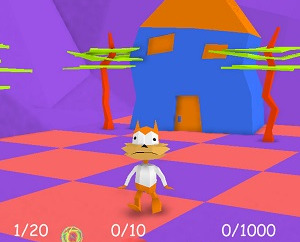
1. museum bubsy:
i love bubsy bobcat's ghastly, staring eyes, which look past everything around him, as if he were the dead theologian mentioned in swedenborg - who upon death simply moves without knowing into a new eternal house shaped exactly like his own, but which over time begins to grow dimmer, more transparent, he finds rooms he's never seen before, populated by dead and faceless men, themfurniture and writings fade, until we can only imagine some final increment of ghostliness leads to the awful truth that - - aaah!!
but of course the distance in bubsy's stare comes from a different location, not so much the gulf between the living and the dead as that between the living and the 90s. bubsy looks at us from the depths of a bubsy 3d that NEVER ENDED, that rather than being a temporary and ignoble home for the hovering bubsy spirit (as expressed in various promotional materials) has somehow become the final determining limit for where that spirit can go. bubsy can explore any kind of content, go on any kind of adventure.. once it is re-expressed within the conditions of this mangled polygonal plain.....
i think that it's so easy (and so profitable!!) to fall into a sort of idealist conception of videogame history as one of various platonic bogeys (truth! gameplay! mario!) temporarily given shape in base matter before disintegrating to appear in some new form. we don't really think those material expressions have anything to say about their spirits, obviously mario isn't "really" as chunky and polygonal as he is in mario 64, just as videogames as a form can easily be distinguished from any of the various rather sad attempts to embody that form. so it's a real shock to find our credit rescinded and be told, no, this is what you have. bubsy is trapped inside his temporary emblem, inside a world he never made, drifting around haplessly and at last thrust towards that final refuge of the doomed, which is the effort to at least be Cultured. do his unseeing eyes still register a sense of potential alterity in the artwork he consumes, or just the frozen parody of same?
2. personal bubsy:
interestingly very few of the bubsy fangames try to replicate the protagonist's canon personality at face value, very likely because it's unbearable. but maybe also for other reasons. the bubsy games themselves play with the idea of bubsy as either an actor seperable from the gameworlds he inhabits ("bubsy the bobcat in claws encounters of the furred kind") or as at least possessing a kind of bugs-bunny-ish awareness of an audience (who are all those quips addressed to?). but that's within the games' own conception of themselves as exciting blockbuster product - taking them as failures of one kind or another as it's become standard to do converts bubsy's actorliness from that of the starring attraction to a sort of jobbing z-movie shlub, mired in one contractual dispute after another and forced through a variety of ill-concieved ventures. and i say interestingly because as far as i can see there's little to support this good will or sense of implied interiority - i'm not aware of gex, say, or duke nukem being extended the same kind of escape clause from their own insufferability. maybe the sheer unbelievability of what these games are telling us about themselves, as mediated through some decades of bubsy trash-talk, gives them a plaintive quality.
3. omnipresent bubsy:
i made a bubsy bobcat fangame once because i thought it would be funny to have a fangame for a character nobody actually liked. it got picked up and reposted by a bubsy fanblog a few days later ("Added for the sake of Bubsy completeness... man this looks bad... but you can download it XD".)
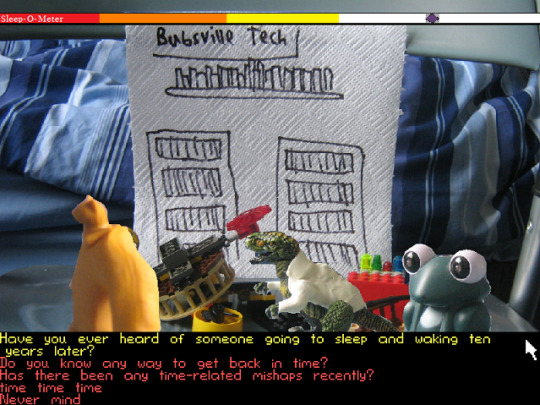
4. dialectic bubsy:
to clarify: i made a bubsy bobcat fangame because i wanted to be funny, but i also wanted to be annoying. i was interested in the "indie games" scene (as distinct from the rpg maker one) and in 2009 the public face of that was very much High Designist, minimal, meaningful, squares, grids, programming, Passage, etc..
i was making a game for an experimental gameplay workshop open jam and figured since i lacked all qualification for this style of art i might as well deliberately disqualify myself from it and make something that was sort of ostentatiously mired in the same junky, unreflective commercial culture that stuff was trying to escape. so it was partly a tease, but not a very dangerous one. bubsy was so visibly, universally reviled within videogame culture that it was hard to imagine any kind of sincere identification with the character taking place - using that franchise therefore meant being able to convert the ickier associations of the fangame format (unoriginal!! un-"challenging"!! made by and for hobbyists and women!!) into more aestheticised, and also more acceptable, forms of disagreeability ("punk" recontextualisation and deliberate badness, etc). so it's a funny ugliness but also one that relies on a sort of shared, unquestioned sense of what's genuinely "un-touchable" in this artsy context, and of course bonding over mutual agreement on what's beyond the pale of acceptable taste is one of the founding rituals of "gamer culture". i'd never played a bubsy game and probably only knew about the franchise from seanbaby or something like that.
what happened next is more interesting. i'd made a game called space funeral, which was popular enough on gamejolt to generate a fairly active fanart tag and even some fangames, a number of fangames all by different authors and with different approaches. and one of the fangame authors ended up playing my own bubsy fangame and decided to re-include bubsy as a character in space funeral 4 as something of a callback to that. i think (forgive me, i only browse the tag) this slowly became the occasion for some drama within "the community". Words Were Said re. furries and the appropriateness of same within this context, bubsy continued gaining more and more of a prominent role in the new fangame, "new bubsy" was also reimagined as a trans sex worker with an extremely prominent chest, these decisions appeared to be contentious, eventually the developer of SF4 declared that they were sick of the fandom, sick of the original game, and going to start a new project based entirely around their new bubsy character.... all of which is well and good and Culture In Action and frankly i stopped having any opinion about space funeral long before the first fangame came out. but what i'm interested in here is bubsy, and specifically the idea of how the deliberate reuse of the bubsy character acts as a way to thematise and re-engage whatever's felt to be awful, unacceptable, within some specific space. in rip van bubsy that means pushing against artgame's more apollonian efforts with a reminder of the garish, lumpen, unsignifying qualities of most actually existing videogames; in space funeral 4, the ironic repurposing and sexlessness of games like rip van bubsy and space funeral is itself critiqued by a sincere / artless / horned-up reusage of the same material which is similarly "unacceptable" within that framework. the travelling figure of bubsy appears as an index of dissent around the format...
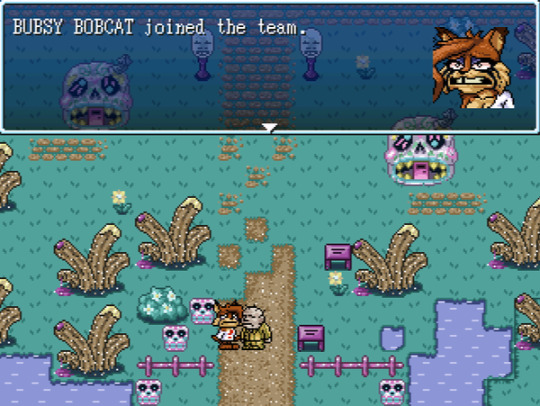
5. negative bubsy:
i think it's a known and documented phenomenon that punk music has a weird, recurring affinity for the purest of pure MOR pop - sex pistols, the clash, nirvana all known abba fans, the minutemen covered steely dan, sonic youth the carpenters, madonna floats across michael azerrad's "our band could be your life" as eerily recurring presence and talisman... all of which might just be a catalog of private tastes. but it's also tempting, given that in seperate ways these were all very self-fashioned, ideological, image-alert bands, to take this taste for pure pop as to some extent deliberate, as maybe part of the same self-fashioning. the very distance of abba from anything approaching punk, noise, art-rock, becomes a reason to like them - they become a kind of model of aesthetic autonomy, serenely detached from any kind of taste or wider expectation - abba are a vantage point from which you can critique punk rock itself. and punks and abba become comrades in their mutual distance from pink floyd("horseshoe theory").
why so many art games about bubsy? there are many perverse or ironic reasons, but i wonder if one of them could be that he occupies something of the same role within the videogames imagination. the idea of a franchise for a character nobody likes turns into an image of art for art's sake. the fact that bubsy is irredeemable from a "meaningful, expressive" perspective makes him useful as a point from which to hypothesize forms of art which deliberately avoid the meaningful or expressive - as in ulillillia's marvellous bubsy 3d videos, which transform the game into a oulipean suite of detached operations.
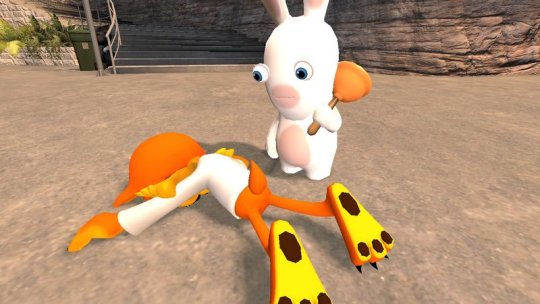
6. material bubsy:
the recieved idea of the mid-1990s mascot platformer audience is like the old analogy of the pre-revolution french peasant as a man walking up to his nose in water - while the ground is flat, he can persist indefinitely, but come the slightest decrease or pothole he will instantly drown. with the bubsy games as tipping point for the temporary demise of this form. but it's still curious that he was chosen, rather than, say, zool or cool spot, mascots who were "worse" on an objective moral level in that they were literally marketing contrivances to sell snack food to children. the videogames audience is traditionally able to accept any level of ghoulishness of this kind as long as it is presented in an appropriately humble,relateable way - the only sin really punished is that of pride, of getting above your station. so here we have a sort of martyr-bubsy, whose only real crime was not exemplifying videogame industry hubris and cynicism so much as making insufficient effort to cover for it...
well, maybe not, maybe we should honor the "disproportionate" scapegoating of bubsy as a real moment of disgust at the habitual crapness of mass media and avoid that charitable revisionism which is so easily rolled out to brands with the power to outlive many of their critics. but there is a certain fascination that comes with those games blamed for or associated with some kind of crash, collapse - - like the atari ET game, they can no longer be regarded as "just games" operating within some fixed economic niche, they fall partly out of that niche and into the material world, they temporarily dispel the sensed changelessness of the industry. if ET really did destroy the industry it would be the best videogame ever made. bubsy never acquired this glamour, but it means that within the awful pantheon of named videogame characters he's one of the few which can be identified with any kind of negative drive, which gives him a special affinity for hobbyist games interested in tarrying with that drive.
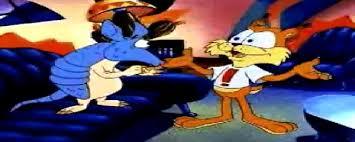
7. official bubsy:
how many bubsys can you shut up? in 2016 a new, official bubsy game was released for pc and ps4, proving once and for all that that is not dead which can eternal lie, and came with a nauseating press-release-cum-interview with bubsy himself in which he ruminates smugly about his ensuing return to planet earth. the fake interviewer glosses the weird and largely negative history of the franchise (bubsy is a "gaming legend", apparently - i can't see anyone described as a "legend" without thinking of those awful laddish testimonials to the likes of boris johnson and raoul moat); bubsy throws in an unexpected jab at "unauthorized indie pixel games and deeveeart portraits", suggesting he's at least seen space funeral 4; the overall tone is that same bullying landlord chumminess of people deposed by scandal who pop up on the chat show circuit five years later with memoir in tow, blandly self-certain about the place they deserve to keep in public life. whatever human meaning had accrued to the franchise - in failure, in the way that failure could be used, repurposed, in wider ongoing arguments about culture - is firmly pushed away, in favour of that strangely anonymous recognition-without-history that constitutes ultimate value for any IP.
but it's also hardly unexpected - nothing dies anymore, even those forms whose only interest was in death, and we're of course not restrained by the threatening (litigious?) distinction between authorized and unauthorized versions of the same wretched official culture. better just to see it as yet another fan-bubsy to add to the catalog- a horrible-undead-persistence-under-capitalism bubsy, a bubsy that now signifies as well as everything else the monolithic stupidity by which "authorized" culture attempts to safeguard its possessions. so maybe we will see this new bubsy start to emerge places as well, an all-new emblem of the negative, emerging where you want it least... a bubsy for our time..!!!
[image tags: bubsy visits the james turrell retrospective, bubsy the bobcat in rip van bubsy starring bubsy, space funeral 4, “rabbid better than bubsy” by shinxboy on deviantart, bubsy animated tv show]
57 notes
·
View notes
Text
A LOOK AT ATTACK ON TITAN (BOTH LIVE ACTION FILMS)
As a movie by itself, it can be considered competent, but as a reimagining of a series with lore, I think I hate these movies. AoT has taken the world by storm, it is a cultural phenomenon recognized all around the world by adults and children alike. Maybe that’s a bit of stretch, but it is highly popular, and as is the case with such things movies will be made to capitalize on the property. But instead of doing the sensible thing and make an animated movie with a throwaway villain and cranked up animation like most other franchises, we get 2 live action movies. And by 2 live action movies, I mean one movie split in two and separated by a crudely placed recap montage.
The first film establishes a similar premise that we’re familiar with from the manga and anime. Human beings are driven to the brink of extinction by giant man eating titans and are forced to live behind walls. Eren, Mikasa and Armin are staring in awe of the wall when suddenly the colossal titan appears. Taking several kicks to punch the iconic hole in the wall yet somehow there’s still rubble flying around for many minutes, the titans inevitably get in and get down to munching. Eren is out of shape and gets forced into a shelter by a slow moving crowd and is forced to watch Mikasa “get killed” by the titans. Time passes and Eren is now in the survey corps, and the 3D gear has been conveniently invented to fight the titans. So they are sent out to the boonies and they are all but wiped out. Thankfully Mikasa and Shikishima save them, but Eren gets eaten, then he turns into a titan without any of the subtlety, kills the surrounding titans, changes back, his little body pops out and the movie pretty much ends.
The second movie begins with a brief recap of the events of the last movie, then we cut to a scene of Eren’s parents injecting him with the titan power before the military police arrest them or kill them. We then cut to Eren in chains and on trial after it’s discovered he can become a titan. Before the matter can be settled, a titan who’s a cross between Eren’s titan form and the armored titan steals him away. Eren then wakes up to a soothing song from a juke box and Shikishima is there to give some exposition. The setting they reside is the post apocalyptic leftovers of what was once Japan, and the titans are a failed japanese weapons experiment turned into an epidemic. Meanwhile the survey corps is picking a bomb to use on the wall to block the hole with rubble. Later as they approach the wall, they meet Shikishima, Eren and militants touting rocket launchers and fully automatic assault rifles, and fighting breaks out. Turns out Shikishima is the bad titan and he and Eren fight, the colossal titan shows up to blow hot air, Jean dies, Shikishima changes his ways and then shoves the bomb down the colossal titan’s throat, he explodes, Eren and Mikasa get a close up while looking out on the ruins of a japanese city, and the movie ends.
It became very evident that the story was overhauled from the source material in order for it to focus around Eren. This to me becomes the first major problem with the movie. In the original series, Eren had some shining character moments, but that was largely credited towards the use of subtlety. Especially when Eren becomes a Titan for the first time, in the live film we immediately see the transformation upon his consumption by the beard titan, and it’s so abrupt that it becomes more of a plot convenience than a plot twist. In the original story, Eren would often be put to the side in order for us to actually miss him a little and give some spot light to the rest of the cast.
A lot of tension is lost because all the plot convenience happens to the benefit of Eren all at once. Nothing is paced out the way it was in the manga to give the emotional impact that it should. It makes him feel like an 80s actions hero.
The second biggest problem is they have removed a lot of characters, which is a good and bad thing. Good in the sense that films won’t be crammed with characters and glazes over arcs like in other adaptations such as the Rurouni Kenshin movies. However, they removed a lot of vital characters needed to give depth to the motivations of other characters. For example, Eren’s parents were removed (at least for the first movie), and his motivations for fighting titans is replaced with “losing” Mikasa. Eren’s original squad was removed and pretty much replaced by a single mom to carry the emotional weight. All the cool and seasoned captains and commanders were removed on top of that.
Also Levi was removed despite how vital and VERY POPULAR he is. And he is replaced with Shikishima, and I really hate this guy. He isn’t much help, he lacks history or depth by being crudely shoe horned into the story and Mikasa is given a romantic interest in him as a lousy attempt at anchoring him down to relevancy. All it succeeded in doing was pissing me off. Not to mention he eats apples, which I’m pretty sure is just a gimmick to get us to think he’s cool while he stands “stoically” on a building top while people die around him.
Other issues I had with the movie were as follows.
1. Passable Green Screen but that’s to be expected from japanese cinema and it wouldn’t be fair to judge this on the same prerequisites that I judge movies with like Captain America or super hero movies in general.
2. The climax and the 1 hour last half of the movie takes place in the ruins of apartment buildings, this stagnant scene usage becomes boring relatively quickly.
3. I can’t sympathize for all the people that died either. The story opens by stating that the Titans appeared 100 years ago, yet none of the fail safes exist as they did in the manga to keep the body count low. Also this movie uses the lazy horror film trope of making people move very little in order to let the slow moving monsters catch up and hopefully look scary but it became irritating to watch after a while.
4. If they were going to add something interesting, they should have expanded on the story from Mikasa’s perspetive. It’s implied that she’s getting a lot of experience pretty much surviving in the thick of Titan territory, that would have been a much more interesting story as long as Shikishima is retconned with extreme prejudice.
Character traits are over exaggerated making the characters into cartoonish shells of their main series counterparts.
Sasha keeps eating potato after potato after potato.
Hanji actually made me tear up, her personality was played up so much. By that I mean just take her obsessive analytical mind and childish satisfaction and add yelling. Lots of yelling.
Eren yells at the sky a lot. Stop being such a queen live action Eren.
And that’s just the first movie.
In just an hour and 20 minutes, the second movie squeezes in an origin story of this actually being our world and Titans are an experiment gone wrong. It squeezes in Eren’s parents at the beginning. Let’s see, there are some automatic rifles, some surface to air missiles and more bad green screen. However, the two points of gratification I got from the second movie were Jean dying and the Titan fights. The titan fights used actual actors in model cities just like monster movies of the past, it was violent, it was dopey, but it was entertaining.
These movies are just not good, or at least this one movie isn’t good. Too much is crammed in yet too many essential elements are removed. Mikasa is a sour deviation in the long run with her dependence towards her awful new love interest. It annoyed me the the 3D gear lost all of its history and happens just about instantaneously for the benefit of the current circumstances. And the characters they added to replace others are just……dorky.
Both Live Action Attack on Titan films get a collective 5 out of 10.
Sure the 2nd movie’s ending is sequel bait, but I wouldn’t hold my breath.
0 notes